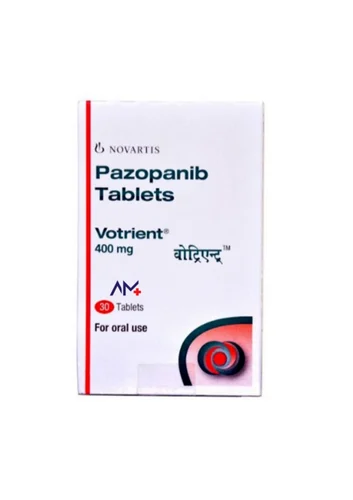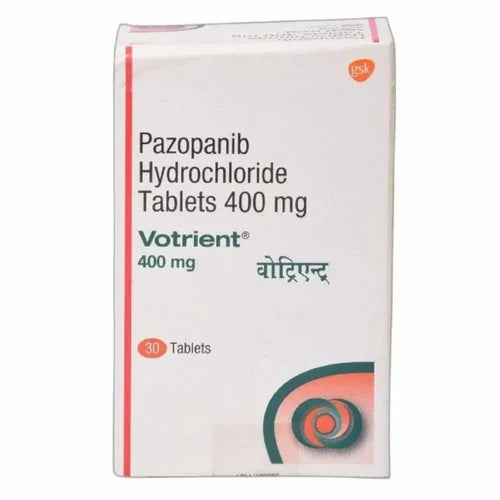GlaxoSmithKline plc
Pazopanib/Votrient
Pazopanib/Votrient
Couldn't load pickup availability
1. Basic information of the drug
Generic name: Pazopanib
Product Name: Votrient
Other name: Pazopanib
2. Indications
Renal cell carcinoma (RCC): Indicated for the treatment of advanced renal cell carcinoma in adults.
Soft Tissue Sarcoma (STS): Indicated for the treatment of adult patients with advanced soft tissue sarcoma who have previously received chemotherapy.
Limitations of Use: Efficacy in patients with adipocyte STS or gastrointestinal stromal tumors (GIST) has not been established.
3. Usage and Dosage
Recommended dose: 800 mg (four 200 mg tablets) orally daily on an empty stomach (at least 1 hour before or 2 hours after a meal) until disease progression or intolerable side effects occur. Tablets should be swallowed whole to avoid crushing. If a dose is missed and the next dose is less than 12 hours away, skip that dose.
Dose Adjustment: Dose adjustment is necessary for patients with impaired liver function or concomitant use of specific medications. For patients with RCC, the initial dose can be reduced to 400 mg/day, further reduced to 200 mg/day. For patients with STS, the initial dose can be reduced to 600 mg/day, further reduced to 400 mg/day. Patients who cannot tolerate further dose reductions should discontinue the drug.
Hepatic impairment: Patients with moderate hepatic impairment (total bilirubin >1.5 to 3 times ULN and elevated ALT) are advised to switch to other medications. If necessary, the dose should be reduced to 200 mg/day. Patients with severe hepatic impairment should not use this drug.
Drug Interactions:
Avoid co-administration with strong CYP3A4 inhibitors or inducers. If necessary, adjust the dose or switch to a non-interacting drug.
Avoid using it simultaneously with gastric acid reducers. If necessary, choose short-acting antacids and administer them separately.
4. Adverse Reactions
Common adverse reactions in RCC patients (≥20%) include diarrhea, hypertension, hair color changes, nausea, fatigue, anorexia, vomiting, etc.
Common adverse reactions in STS patients (≥20%) include fatigue, diarrhea, nausea, weight loss, hypertension, decreased appetite, vomiting, tumor pain, hair color changes, musculoskeletal pain, headache, taste disturbance, dyspnea, and skin hypopigmentation.
Serious adverse events such as polycythemia, retinal detachment/tearing, pancreatitis, tumor lysis syndrome (including fatal cases), arterial (including aortic) aneurysm, dissection and rupture (including fatal cases) have also been reported after marketing.
V. Storage conditions
Store between 20°C and 25°C (68°F and 77°F). Short-term storage permitted between 15°C and 30°C (59°F and 86°F).
VI. Mechanism of Action
Pazopanib is a multi-targeted tyrosine kinase inhibitor that acts on receptors such as VEGFR-1, VEGFR-2, VEGFR-3, PDGFR-α and -β, FGFR-1 and -3, Kit, Itk, Lck, and c-Fms. It inhibits angiogenesis and tumor growth by inhibiting the autophosphorylation of these receptors and downstream signaling pathways.
7. Overdose Management
In cases of overdose (e.g., 2000 mg or 1000 mg daily), dose-limiting toxicities such as grade 3 fatigue and hypertension may occur. General supportive care should be provided, and hemodialysis is ineffective for the clearance of pazopanib because it is not significantly excreted by the kidneys and is highly bound to plasma proteins.
Pazopanib is a multi-tyrosinase inhibitor targeting vascular endothelial growth factor receptors (VEGFR-1, VEGFR-2, and VEGFR-3), platelet-derived growth factor receptors (PDGFR-α and -β), fibroblast growth factor receptors (FGFR-1 and -3), cytokine receptor (Kit), interleukin-2 receptor inducible T-cell kinase (Itk), leukocyte-specific protein tyrosine kinase (Lck), and transmembrane glycoprotein receptor tyrosine kinase (c-Fms). In vitro studies have shown that pazopanib inhibits ligand-induced autophosphorylation of VEGFR-2, Kit, and PDGFR-β. In vivo studies have shown that pazopanib can inhibit VEGF-induced VEGFR-2 phosphorylation in the lungs of mice, angiogenesis in mice, and the growth of human tumor xenografts in mice.
absorb:
The median time to maximum plasma concentration after oral administration of pazopanib is 2 to 4 hours. The geometric mean AUC and Cmax of pazopanib at a daily dose of 800 mg were 1,037 hr•μg/mL and 58.1 μg/mL (equivalent to 132 μM), respectively. Pazopanib doses exceeding 800 mg daily did not result in a concomitant increase in AUC or Cmax.
Administration of a single crushed pazopanib 400 mg tablet increased AUC (0-72) by 46%, increased Cmax by approximately 2-fold, and decreased tmax by approximately 2 hours compared to administration of the whole tablet. These results suggest that crushing the tablet increases the bioavailability and oral absorption rate of pazopanib. Therefore, to avoid increased drug exposure, VOTRIENT tablets should not be crushed.
Concomitant administration of pazopanib increases systemic exposure to pazopanib. Concomitant administration of pazopanib with either a high-fat or low-fat meal increases the AUC and Cmax by approximately 2-fold. Therefore, pazopanib should be taken at least 1 hour before or 2 hours after a meal.
distributed:
Pazopanib is over 99% bound to human plasma proteins. This binding is unaffected by concentration between 10 and 100 μg/mL. In vitro studies have shown that pazopanib is a substrate for P-glycoprotein (P-gp) and breast cancer resistant protein (BCRP).
metabolism:
In vitro studies have shown that pazopanib is primarily metabolized by CYP3A4, and to a lesser extent by CYP1A2 and CYP2C8.
Elimination: Following administration of the recommended dose of 800 mg, pazopanib has a mean half-life of 30.9 hours. Elimination occurs primarily via feces, with renal excretion accounting for <4% of the administered dose.
In vitro studies of drugs that inhibit or induce CYP450 3A4 have shown that the oxidative metabolism of pazopanib in human liver microsomes is primarily influenced by CYP3A4, with less influence from CYP1A2 and CYP2C8. Therefore, CYP3A4 inhibitors and inducers may affect pazopanib metabolism.
CYP3A4 Inhibitors : Concomitant use of pazopanib with strong CYP3A4 inhibitors (e.g., ketoconazole, ritonavir, clarithromycin) may increase pazopanib concentrations. If concomitant use of a strong CYP3A4 inhibitor is necessary, a dose reduction of VOTRIENT should be considered. Grapefruit juice should be avoided as it inhibits CYP3A4 activity and may increase pazopanib plasma concentrations.
CYP3A4 Inducers: CYP3A4 inducers (e.g., rifampin) may decrease pazopanib plasma concentrations. VOTRIENT should not be used if long-term use of strong CYP3A4 inducers is unavoidable.
Novartis Votrient
Pazopanib instructions
Pazopanib
We can buy the magic weight loss drug Rybelsus here. Three boxes for $240.
Share




